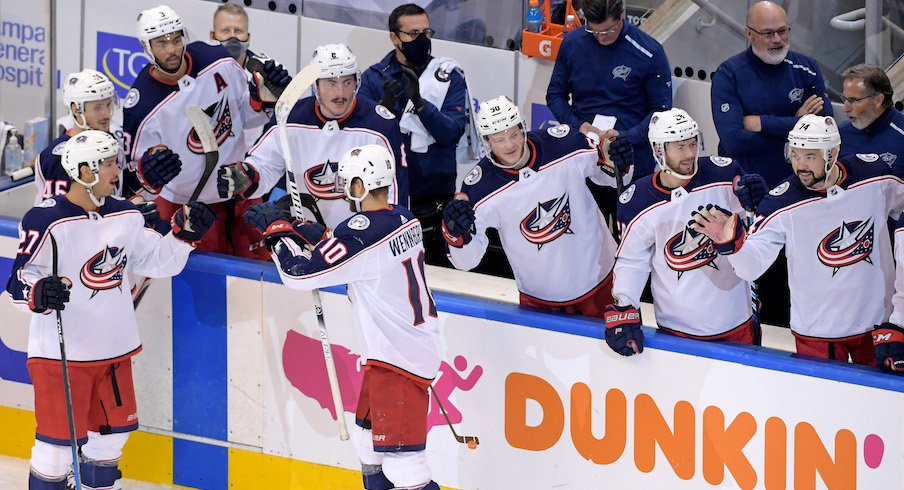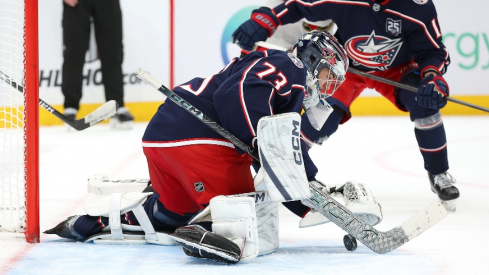For two decades, the Blue Jackets have taken the ice in Columbus.
Recently, with coach John Tortorella and general manager Jarmo Kekalainen in charge, things have picked up for the franchise. The past two years, Columbus has won postseason series, marking the first two playoff series victories ever. It has also finished above .500 fives times in the past decade.
So, how does the 2019-20 team that just got eliminated in the first round of the Stanley Cup playoffs stack up to past years in Blue Jackets history? That's what we're trying to find out by comparing all 19 years of franchise history in 10 statistical categories.
Points Percentage
- The 2016-17 season: 65.9%
- The 2018-19 season: 59.8%
- The 2017-18 season: 59.1%
- The 2019-20 season: 57.9%
- The 2012-13 season: 57.3%
- The 2013-14 season: 56.7%
- The 2008-09 season: 56.1%
- The 2014-15 season: 54.3%
- The 2010-11 season: 49.4%
- The 2007-08 season: 48.8%
- The 2009-10 season: 48.2%
- The 2015-16 season: 46.2%
- The 2005-06 season: 45.1%
- The 2006-07 season: 44.5%
- The 2000-01 season: 43.3%
- The 2002-03 season: 42.1%
- The 2011-12 season: 39.6%
- The 2003-04 season: 37.8%
- The 2001-02 season: 34.8%
More often than not in the franchise's history, the Blue Jackets haven't earned even half of the possible points – which are gained based on the result of each regular-season game. But lately, they've had some of their winningest seasons since their creation.
In fact, the last four seasons have been their best four seasons – at least, based on points percentage. With a 33-22-15 record in the shortened 2019-20 regular season, Columbus had its fourth-best points percentage ever.
Goals Scored Per Game
- The 2018-19 season: 3.12
- The 2016-17 season: 3.01
- The 2017-18 season: 2.88
- The 2014-15 season: 2.77
- The 2013-14 season: 2.76
- The 2008-09 season: 2.68
- The 2005-06 season: 2.62
- The 2009-10 season: 2.61
- The 2002-03 season: 2.60
- The 2015-16 season: 2.60
- The 2019-20 season: 2.57
- The 2010-11 season: 2.56
- The 2011-12 season: 2.41
- The 2012-13 season: 2.40
- The 2006-07 season: 2.39
- The 2000-01 season: 2.32
- The 2007-08 season: 2.32
- The 2003-04 season: 2.16
- The 2001-02 season: 2.00
Columbus hasn't exactly earned a reputation as a goal-scoring haven. More often than not, it's ranked near the bottom of the NHL, and that was no different in the recently-completed season.
In 2019-20, the Blue Jackets scored 2.57 goals per game, which placed them 28th in the 31-team league. Yet, underscoring their unimpressive offensive history, that mark barely ranked this year's team in the bottom half when holding it up against Columbus groups of the past.
Goals Against Per Game
- The 2016-17 season: 2.35
- The 2012-13 season: 2.40
- The 2007-08 season: 2.56
- The 2019-20 season: 2.61
- The 2013-14 season: 2.61
- The 2008-09 season: 2.72
- The 2017-18 season: 2.76
- The 2018-19 season: 2.82
- The 2000-01 season: 2.84
- The 2003-04 season: 2.90
- The 2006-07 season: 2.98
- The 2015-16 season: 3.02
- The 2014-15 season: 3.02
- The 2009-10 season: 3.04
- The 2010-11 season: 3.05
- The 2001-02 season: 3.11
- The 2011-12 season: 3.13
- The 2002-02 season: 3.21
- The 2005-06 season: 3.37
Only three other times in franchise history has Columbus allowed fewer goals per game than it did in the 2019-20 regular season. Because of a lacking offense that wasn't nearly as consistent as it needed to be, John Tortorella's team relied heavily on its defense, which rewarded him with steady play throughout the campaign with Joonas Korpisalo and Elvis Merzlikins at goaltender.
The Blue Jackets' goals-against average held up league-wide, too. They ranked third in the NHL with their average of 2.61 goals allowed per game.
Average Goal Differential Per Game
- The 2016-17 season: 0.68
- The 2018-19 season: 0.31
- The 2013-14 season: 0.16
- The 2017-18 season: 0.11
- The 2012-13 season: 0.03
- The 2008-09 season: -0.01
- The 2019-20 season: -0.12
- The 2014-15 season: -0.16
- The 2007-08 season: -0.16
- The 2015-16 season: -0.38
- The 2009-10 season: -0.42
- The 2006-07 season: -0.42
- The 2000-01 season: -0.44
- The 2010-11 season: -0.45
- The 2002-03 season: -0.51
- The 2011-12 season: -0.65
- The 2005-06 season: -0.66
- The 2003-04 season: -0.72
- The 2001-02 season: -0.97
If there's a single statistic that highlights Columbus' struggles in the 2000s, it's this one. Not even once during the decade did the team score more goals than it allowed. That changed in the 2010s, with the Blue Jackets scoring more goals than they gave up in five seasons.
Yet in the 2019-20 regular season, they had an average goal differential of -0.12 with 180 goals scored and 187 goals allowed.
Power-Play Percentage
- The 2014-15 season: 21.7%
- The 2016-17 season: 19.9%
- The 2013-14 season: 19.3%
- The 2009-10 season: 18.2%
- The 2015-16 season: 17.3%
- The 2002-03 season: 17.3%
- The 2017-18 season: 17.2%
- The 2019-20 season: 16.4%
- The 2011-12 season: 15.5%
- The 2018-19 season: 15.4%
- The 2007-08 season: 14.9%
- The 2006-07 season: 14.8%
- The 2000-01 season: 14.7%
- The 2003-04 season: 14.5%
- The 2012-13 season: 14.2%
- The 2005-06 season: 14.2%
- The 2010-11 season: 14%
- The 2001-02 season: 14%
- The 2008-09 season: 12.7%
While this season's power play wouldn't be mistaken for a deadly unit, it actually ranked in the upper half when comparing it to years of the past. Zach Werenski and Emil Bemstrom led Columbus with five goals apiece on power plays, with their team scoring on 16.4 percent of its opportunities. That ranked 27th in the NHL.
To put the Blue Jackets' power-play issues over the years into perspective, their second-best mark ever – 19.9 percent in the 2016-17 season – would be the 16th-best power-play scoring rate in the NHL this season. In other words, it wouldn't even crack the top half of the NHL.
Penalty-Kill Percentage
- The 2002-03 season: 85.3%
- The 2003-04 season: 85.2%
- The 2018-19 season: 85%
- The 2007-08 season: 83.3%
- The 2001-02 season: 83%
- The 2012-13 season: 82.6%
- The 2016-17 season: 82.5%
- The 2013-14 season: 82.1%
- The 2008-09 season: 82.1%
- The 2005-06 season: 81.8%
- The 2019-20 season: 81.7%
- The 2009-10 season: 81.7%
- The 2006-07 season: 81.2%
- The 2015-16 season: 81%
- The 2000-01 season: 80.7%
- The 2010-11 season: 80.3%
- The 2014-15 season: 80.2%
- The 2011-12 season: 76.6%
- The 2017-18 season: 76.2%
Most years, Columbus has done its best to make up for a not-so-great power play with a solid penalty-kill group. That applies to the 2019-20 season, as well, with its 81.7 percent kill rate ranking 12th in the NHL.
Even early in the franchise's history, the Blue Jackets were a consistent unit on the penalty kill, and that's remained the case under Tortorella.
Shooting Percentage
- The 2018-19 season: 9.9%
- The 2002-03 season: 9.9%
- The 2016-17 season: 9.7%
- The 2014-15 season: 9.6%
- The 2005-06 season: 9.6%
- The 2013-14 season: 9.3%
- The 2008-09 season: 9.3%
- The 2009-10 season: 9.2%
- The 2000-01 season: 9.1%
- The 2012-13 season: 9.0%
- The 2015-16 season: 8.9%
- The 2006-07 season: 8.6%
- The 2017-18 season: 8.5%
- The 2010-11 season: 8.4%
- The 2011-12 season: 8.1%
- The 2007-08 season: 8.0%
- The 2001-02 season: 8.0%
- The 2019-20 season: 7.9%
- The 2003-04 season: 7.8%
Here's where the losses of Artemi Panarin and Matt Duchene are most evident. Columbus put up its best-ever shooting percentage (9.9) in the 2018-29 season, then it followed the mark up by recording its second-worst mark (7.9) during the 2019-20 season.
It's no secret that the Blue Jackets weren't a particularly efficient shooting team this year, and the statistics spell that out, as well. Oliver Bjorkstrand did what he could to increase the shooting percentage with a team-high 13 percent scoring rate on his shots.
Save Percentage
- The 2016-17 season: 92.2%
- The 2012-13 season: 92%
- The 2013-14 season: 91.5%
- The 2017-18 season: 91.2%
- The 2019-20 season: 91.3%
- The 2014-15 season: 91%
- The 2003-04 season: 90.9%
- The 2007-08 season: 90.7%
- The 2000-01 season: 90.6%
- The 2018-19 season: 90.4%
- The 2015-16 season: 90.3%
- The 2009-10 season: 90.1%
- The 2008-09 season: 90.2%
- The 2005-06 season: 90%
- The 2002-03 season: 90%
- The 2011-12 season: 89.9%
- The 2010-11 season: 89.8%
- The 2001-02 season: 89.7%
- The 2006-07 season: 89.6%
With Sergei Bobrovsky in the net, Columbus had two of its four best save percentages. Yet the year after he left, due to the stellar play of Korpisalo and Merzlikins, the Blue Jackets had a top-five save percentage in franchise history, which also ranked tied for fourth in the NHL.
To further break down this year's 91.3 percent save rate, Merzlikins saved 92.3 percent of the shots that were sent his way and Korpisalo secured saves on 91.1 percent of opposing shots.
Face-Off Win Percentage
- The 2007-08 season: 52.3%
- The 2012-13 season: 52%
- The 2013-14 season: 51.6%
- The 2010-11 season: 51.2%
- The 2008-09 season: 51.2%
- The 2009-10 season: 51%
- The 2011-12 season: 50.9%
- The 2018-19 season: 50.2%
- The 2014-15 season: 49.3%
- The 2015-16 season: 49%
- The 2016-17 season: 48.6%
- The 2019-20 season: 48.5%
- The 2017-18 season: 48.4%
Since the NHL began collecting team face-off win percentage data in the late 2000s, the Blue Jackets rarely fared worse than this season when it won 48.5 percent of chances.
Among those who were given the most face-off opportunities on the team, Boone Jenner stood out for his win percentage of 55.2. Pierre-Luc Dubois and Alexander Wennberg both won fewer than 46 percent of their face-offs.
Penalty Minutes Per Game
- The 2018-19 season: 6.1
- The 2019-20 season: 6.3
- The 2017-18 season: 6.5
- The 2016-17 season: 8.6
- The 2013-14 season: 11
- The 2014-15 season: 11.8
- The 2015-16 season: 12
- The 2012-13 season: 12.4
- The 2011-12 season: 12.5
- The 2009-10 season: 13
- The 2010-11 season: 13.4
- The 2001-02 season: 14.4
- The 2003-04 season: 14.5
- The 2008-09 season: 14.7
- The 2000-01 season: 14.8
- The 2007-08 season: 15.9
- The 2006-07 season: 16.3
- The 2005-06 season: 17
- The 2002-03 season: 18
No metric better shows Tortorella's influence than this one. Just four times in Blue Jackets history have teams averaged fewer than 11 penalty minutes per game, and they all happened during Tortorella's reign, with the past two seasons being the best yet.
Because of his emphasis on discipline, it's fair to anticipate Columbus will continue to average minimal penalty minutes – which, of course, helps a team that has struggled on power plays over the years.

